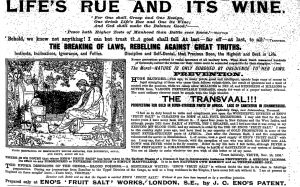19th century
The Modena Fossil
. This is perhaps the most bizarrely named product yet featured on this site. It is not surprising that it should be obscure to the modern observer, but in fact it made no sense to the denizens of the early 19th century either. . . ……………HEALTH ……….A MOST IMPORTANT DISCOVERY. ……….The Modena Fossil ……….A SPEEDY […]
Read MoreAlbert's Grasshopper Ointment
Grasshopper Ointment was registered in 1874 and the name was trademarked in 1884. It was still listed in Martindale’s Extra Pharmacopoeia in 1989, where the ingredients were given as rosin, yellow beeswax, larch oleoresin, arachis oil, white soft paraffin and copper acetate – but no grasshoppers. The copper would have given it a green tint […]
Read MoreRadam's Microbe Killer
Famous for its trademark showing someone walloping the living crap out of a reanimated skeleton (if skeletons can be said to possess any living crap), Radam’s Microbe Killer was a fraud. Its inventor, William Radam, published a book, Microbes and the Microbe Killer (189o) describing at great length his quest for a cure for his […]
Read MoreCharles Forde's Bile Beans for Biliousness
While Bile Beans were initially pitched as a cure for biliousness, the influenza epidemic of 1899 was too good an opportunity to miss. Horrible though the ‘flu was, a lot of people would recover after a week or so anyway, and it was an easy matter for quacks to point to cases where the recovery coincided […]
Read MoreDr MacKenzie’s Improved Harmless Arsenic Complexion Wafers
‘Dr MacKenzie’ was one of several brand names attached to arsenic products – similar ‘wafers’ (pills) were sold under the names Dr Simms, Dr Rose and Dr Campbell. The wafers made the skin fashionably pale by destroying red blood cells. Although it was possible to build up a tolerance for arsenic by taking regular small amounts, it […]
Read More
Eno’s Fruit Salt
Invented in the 1850s by James Crossley Eno of Newcastle, the Fruit Salt sold like hotcakes to sailors looking for something to keep them healthy on long journeys. The product is still available today – now manufactured by GlaxoSmithKline, it sells in vast quantities worldwide and is a popular ingredient in Indian cookery. It contains […]
Read MoreHenry Thompson's Real Cheltenham Salts
Although Henry Thompson claimed to manufacture the salts by evaporating spa water, The Monthly Gazette of Health for 1 Sept 1819 claimed that the product was nothing more than Glauber’s salt (sodium sulphate decahydrate). The Gazette had “been informed, by a gentleman residing in Cheltenham, who could prove the fact, that many tons of common Glauber’s […]
Read MoreJ Gerred, Medical Herbalist (and poet)
Joseph Gerred’s talents as a medical herbalist surpassed his poetic abilities, though judging by the verse in the following advert, that’s not saying much. Born in 1816, he took up herbalism in the 1830s, while also editing his own newspaper, The Devonshire Times. In 1856, Gerred was accused of libel after his paper printed a story claiming that […]
Read More